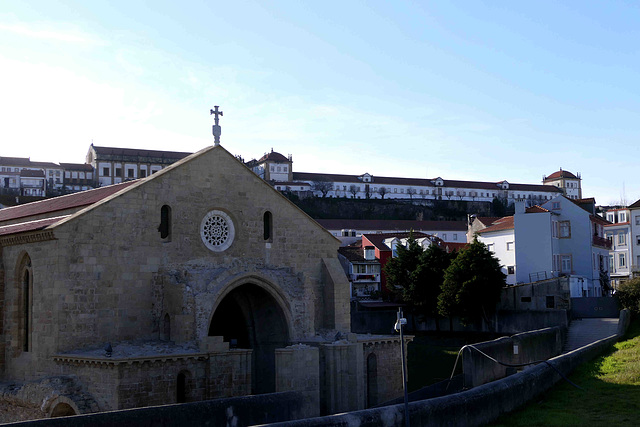Location
Lat, Lng: 40.207301, -8.435611
You can copy the above to your favourite mapping app.
Address: Avenida de Conimbriga, 3040-248, Santa Clara, Coimbra
You can copy the above to your favourite mapping app.
Address: Avenida de Conimbriga, 3040-248, Santa Clara, Coimbra
Keywords
Authorizations, license
-
Visible by: Everyone -
All rights reserved
-
88 visits
Coimbra - Mosteiro de Santa Clara-a-Nova


The town, which was called Aeminium in Roman times, was under the protection of Conímbriga, which was located around 15 kilometers to the south. Administratively, Aeminium was under the influence of the larger city of Conímbriga until it was plundered around 465 by the Suebi and Visigoths and later abandoned. Aeminium took over the bishop's see and the name.
The city was conquered by the Moors in 711. The Moors lost Coimbra again in 878. The Muslim population settling in Coimbra was expelled. In 987, the city was destroyed during the renewed Moorish conquest by the general Almansor. Coimbra was not reconquered until 1064 by King Fernando de Castilla y León. The Moors conquered the city for the last time in 1117, but evacuated it for good after a few days.
Coimbra was the second capital of Portugal when the independent Kingdom of Portugal was founded in 1139. It retained this status until 1256. After Lisbon became the capital, the city's position in the country declined, but it remains important to this day, particularly as a university city, as the university founded by King Dom Dinis in 1290 is the oldest university in Portugal and one of the oldest in Europe.
The monastery was built to replace the mediaeval Monastery of Santa Clara-a-Velha, located nearby near the river, which at the time was prone to frequent flooding by the waters of the Mondego river. The monastery was built in the 17th and 18th centuries.
The Santa Clara-a-Velha was founded in the early 14th century by Queen Elizabeth of Portugal (aka "Isabel de Aragão"), wife of King Dinis I. The queen was greatly admired during and after her life for her pious and generous nature, and was canonised in the 17th century.
In the 17th century it was decided that a new monastery was to be built up on the hill. Construction works began in 1649, and the church was finished by 1696. All nuns as well as the Gothic tombs of Queen Elizabeth and other royal princesses were transferred to the new monastery, therefore called "Santa Clara-a-Nova".
Here in the foreground is Santa Clara-a-Velha and in the background on the hill is the large Monastery of Santa Clara-a-Nova
The city was conquered by the Moors in 711. The Moors lost Coimbra again in 878. The Muslim population settling in Coimbra was expelled. In 987, the city was destroyed during the renewed Moorish conquest by the general Almansor. Coimbra was not reconquered until 1064 by King Fernando de Castilla y León. The Moors conquered the city for the last time in 1117, but evacuated it for good after a few days.
Coimbra was the second capital of Portugal when the independent Kingdom of Portugal was founded in 1139. It retained this status until 1256. After Lisbon became the capital, the city's position in the country declined, but it remains important to this day, particularly as a university city, as the university founded by King Dom Dinis in 1290 is the oldest university in Portugal and one of the oldest in Europe.
The monastery was built to replace the mediaeval Monastery of Santa Clara-a-Velha, located nearby near the river, which at the time was prone to frequent flooding by the waters of the Mondego river. The monastery was built in the 17th and 18th centuries.
The Santa Clara-a-Velha was founded in the early 14th century by Queen Elizabeth of Portugal (aka "Isabel de Aragão"), wife of King Dinis I. The queen was greatly admired during and after her life for her pious and generous nature, and was canonised in the 17th century.
In the 17th century it was decided that a new monastery was to be built up on the hill. Construction works began in 1649, and the church was finished by 1696. All nuns as well as the Gothic tombs of Queen Elizabeth and other royal princesses were transferred to the new monastery, therefore called "Santa Clara-a-Nova".
Here in the foreground is Santa Clara-a-Velha and in the background on the hill is the large Monastery of Santa Clara-a-Nova
Paolo Tanino has particularly liked this photo
- Keyboard shortcuts:
Jump to top
RSS feed- Latest comments - Subscribe to the comment feeds of this photo
- ipernity © 2007-2025
- Help & Contact
|
Club news
|
About ipernity
|
History |
ipernity Club & Prices |
Guide of good conduct
Donate | Group guidelines | Privacy policy | Terms of use | Statutes | In memoria -
Facebook
Twitter











Sign-in to write a comment.